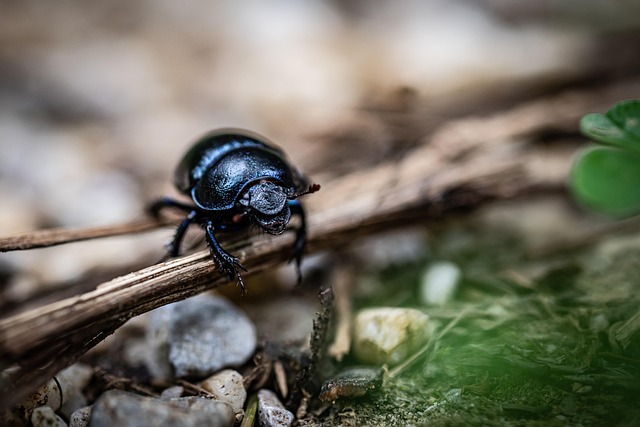Carpet beetles like Anthrenus verbasci and Tineola bisselliana are household pests that damage fabrics, requiring proactive measures for control. Early detection is key, with preventative tactics including regular cleaning, low humidity, and airtight storage. Seasonal strategies, such as spring/summer cleaning, autumn sealing, and winter deep cleaning, offer comprehensive protection. Continuous monitoring through professional inspections is vital, with control methods targeting adults and offspring. Severe infestations may need advanced treatments like insect growth regulators (IGRs) and targeted pesticides, combined with entry point sealing and improved ventilation for long-term carpet beetle infestation treatment.
Carpet beetles can cause significant damage to your home’s textiles, rugs, and furnishings, leading to costly repairs or replacements. Understanding these infestations is crucial for effective prevention. This article guides you through seasonal strategies and year-round protection programs to combat carpet beetles. We’ll explore common types, their impact, and practical steps like monitoring, cleaning, and sealing entry points. For severe cases, discover professional interventions and advanced treatment options, ensuring a carpet beetle-free environment with the help of experts in carpet beetle infestation treatment.
Understanding Carpet Beetle Infestations: Common Types and Their Impact
Carpet beetles are a common household pest that can cause significant damage to fabrics, carpets, and upholstery. Understanding their behavior and life cycles is key to effective prevention and treatment. These insects are part of a diverse group known as textile or fabric beetles, with several common types including the common carpet beetle (Anthrenus verbasci), the fur (or velvet) beetle (Tineola bisselliana), and the case-making cloth beetle (Tyragina latipennata). Each species has unique characteristics and preferences, but they all share a penchant for organic materials, particularly those high in keratin, a protein found in fabrics, hair, and skin cells.
A carpet beetle infestation can quickly escalate if left untreated, as the beetles lay eggs within crevices and fabric layers, leading to rapid population growth. The impact of an infestation goes beyond mere aesthetics; these beetles can cause irreversible damage to valuable textiles and carpets. Early detection is crucial for effective carpet beetle infestation treatment. Regular cleaning, maintaining low humidity levels, and storing fabrics in airtight containers are preventive measures that can significantly reduce the risk of these pests taking up residence in your home or business.
Seasonal Strategies for Effective Carpet Beetle Prevention
In the ever-changing seasons, a dynamic approach to carpet beetle prevention is key to maintaining a pest-free environment. Seasonal strategies play a vital role in effective carpet beetle infestation treatment, allowing for tailored methods throughout the year. During spring and summer, when these beetles are most active, regular vacuuming and cleaning can help eliminate eggs and larvae. Focusing on thorough cleaning, especially in high-risk areas like carpets and upholstery, sets the foundation for prevention.
As autumn arrives, a proactive approach becomes crucial. This includes sealing entry points, such as cracks and gaps, to prevent adult beetles from entering. Applying preventative treatments with natural repellents can deter these pests without resorting to harsh chemicals. Winter offers an opportunity for deep cleaning and professional inspections to identify any existing issues. By combining seasonal strategies with consistent maintenance, homeowners can ensure year-round protection against carpet beetle infestations.
Implementing Year-Round Protection: Continuous Monitoring and Control Measures
Implementing year-round protection for carpet beetles involves continuous monitoring and control measures. Regular inspections are crucial to identifying any signs of an emerging infestation early on, allowing for swift action to prevent the spread. This includes regularly checking carpets, furniture, and other susceptible areas for adult beetles, larvae, or eggs. Professional pest control services can provide ongoing surveillance programs tailored to specific needs, ensuring that any potential carpet beetle infestation is treated promptly.
Control measures should be comprehensive, targeting both adult beetles and their offspring. This may include the application of insecticides, biological control methods, or a combination of both. Regular maintenance, such as vacuuming and cleaning, helps remove beetle larvae and eggs from surfaces and fibers. Additionally, storing items like clothing, fabrics, and upholstery in airtight containers can significantly reduce the risk of attracting carpet beetles, providing an effective long-term carpet beetle infestation treatment strategy.
Professional Interventions and Advanced Treatment Options for Severe Cases
Professional interventions are a crucial step in addressing severe carpet beetle infestations, especially when do-it-yourself methods prove ineffective. Pest control experts employ advanced treatment options tailored to target and eliminate these tiny invaders effectively. One such method involves the use of insect growth regulators (IGRs), which disrupt the beetles’ life cycle by inhibiting their transformation from larvae to adults. IGRs are safe for humans and pets but severely hinder beetle population growth.
Another advanced option is the application of targeted pesticides, which are designed to kill adult beetles upon contact while leaving other insects unharmed. These professional treatments often include a combination of strategies, ensuring a comprehensive carpet beetle infestation treatment. This may include sealing entry points, improving ventilation, and implementing regular monitoring to prevent future outbreaks.
Preventing seasonal carpet beetle infestations requires a multi-faceted approach. By understanding common types and their impact, implementing effective seasonal strategies, adopting year-round protection measures, and knowing when professional interventions are necessary, homeowners can achieve continuous monitoring and control. These integrated pest management (IPM) practices ensure optimal carpet beetle infestation treatment, maintaining a clean and healthy living environment throughout the year.
